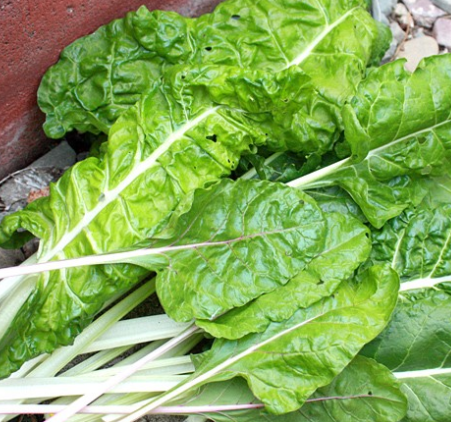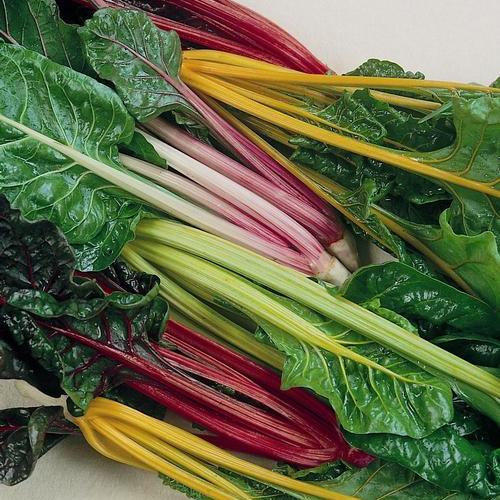
Learning Download: How to Grow Chard
From Seed to Harvest: A beginner’s guide to growing chard.
Swiss chard is another way to eat nutrient-rich, leafy greens. Chard is a member of the beet family, just without the bulb, and ti comes in a variety of different hues. The color does not affect the taste of the chard.
To plant:
Swiss chard does well in a garden as well as a patio pot. Swiss chard seeds can be planted as soon as the soil can be worked, and a little spring frost won’t hurt them. To harvest the crop even earlier, start the seeds indoors and move outdoors when nighttime temperatures are no lower than 28 degrees. Plant the seeds 1/2-inch-deep and up to 1 inch apart in rows set 3 feet apart. This the seedlings to 2 or 3 inches apart, though the plants don’t react poorly to overcrowding.
To grow:
Like most vegetables, Swiss chard does best in full sun. The plant isn’t a picky one though, and it can tolerate some shade. Mulch with grass clippings or compost to add extra nutrients to the plant’s growth, and water moderately. If the plant doesn’t receive enough water, it may become bitter to the taste.
To harvest
Swiss chard grows fast, and it is usually ready to harvest four to six weeks after planting. One crop planting can supply leaves for months. Begin harvesting when the plant reaches 9 inches tall, though the tender baby leaves can be used in fresh salads. Once a leaf is cut, a new one grows in its place. Harvesting can be done be cutting off the individual leaves or cutting the entire plant at its base, about an inch above soil. The plant will still regrow if it is cut.
What chard craves:
Swiss chard requires moderate watering and soil with a pH of 6.0 to 6.5.
Where to buy chard seeds:
You can find a variety of dark, leafy chard seeds at Urban Farmer.
Learning Download: Common pests and diseases: Chard
Common pests and diseases: Chard
When growing vegetables, it is always exciting to care for the plant throughout its growing phase and then harvest it for delicious recipes later on, but one thing to watch out for is pests and diseases. Different plants are susceptible to different types of pests and diseases, and it is important to make yourself aware so you can keep a watchful eye and also take any preventative methods to keep your plants safe throughout their lifespan.
Chard can fall victim to several different pests and diseases.
Pests:
The top three pests that can affect Swiss Chard are aphids, spinach leafminers and flea beetles.
If flea beetles are present, leaves will appear wilted. Use sticky tape to remove the beetles, or spray with a commercial spray that contains pyrethrins. You can also use a homemade spray with five parts water, two parts rubbing alcohol and 1 tablespoon of liquid dish soap.
Spinach leafminers will create long and narrow tunnels in the Swiss chard. Use cheesecloth covers or netting to cover your crop and protect them. You can also use an insecticidal soap spray to treat this pest.
Aphids are a very common issue and can be treated with insecticidal soap spray. Avoid using insecticides here, because it will also kill aphid-eating insects like lady bugs.

Diseases:
There are four main diseases that can affect Swiss chard, and they are leaf spot, downy mildew, cucumber mosaic virus and mystery fungus.
Leaf spot will first appear as reddish brown rings or spots on the leaves. It makes the chard unmarketable. Usually, leaf spot can be caused by long rainy spells during warm weather. Farmers and gardeners alike are encouraged to practice crop rotation, use a seed that isn’t infected and given other tips. However, sometimes the problem can occur anyway if the conditions are favorable. To manage this disease, remove the older leaves that are affected and treat the rest with copper sprays of fungicides.
Downy mildew can be mistaken for powdery mildew, but two are separate issues. Downy mildew is very difficult to control if it affects Swiss chard, and it usually appears at the end of the winter in the spring. The disease can appear on its own and leave new growth unharmed.
Cucumber mosaic virus will slow the growth rate of the plants and affect individual plants instead of the entire crop. To test if the plant is infected, hold the leaves up to the light. Those infected will have fainter mottling than healthy leaves. To manage this virus, work to keep aphids out of the Swiss chard.
Mystery fungus happens when the weather is cool and wet. It attacks the leaves, but it appears as blotches instead of circular spots. It usually affects patches and not the entire crop. Use carbendazim to treat it.

